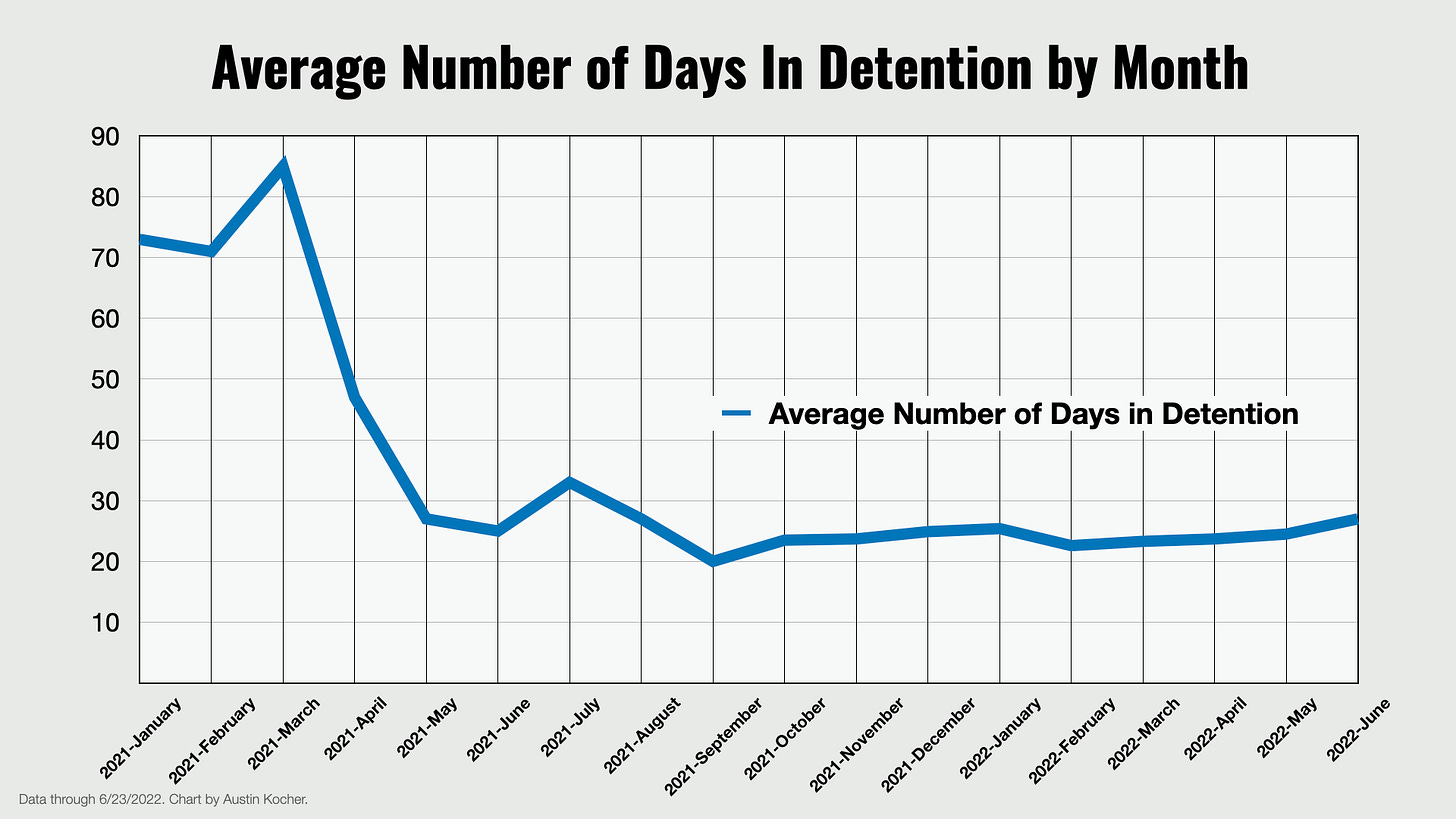The Supreme Court season is in full swing. In addition to overturning Roe v. Wade last week (decision here, reporting here), the Supreme Court may also issue a decision in Biden v. Texas today (explainer here). The ruling could determine whether the Biden administration will be forced to continue the Migration Protection Protocols program.
The Migrant Protection Protocols (MPP) is a program that requires asylum-seekers from certain countries to wait for their asylum hearings in Mexico. By the time you read this, the decision in Biden v. Texas could already be out. Note that if it does come out today, you can click back through to this post and I’ll update with a few reputable resources on the decision.
Despite the fast-moving immigration policy changes, I wanted to start out this week with an overview of the most current immigration data so that anyone reading this, no matter your views on the contentious politics of all this, has access to basic factual information.
What’s going on with MPP 2.0?
Given the forthcoming Biden v. Texas ruling, you may want to take a look at TRAC’s recent report on MPP 2.0: “5,000 Asylum-Seekers Added to the Migrant Protection Protocols 2.0, Few are Granted Asylum.”
That report examined the current status of cases in MPP 2.0, which were added since December 2021. Key findings from the report include:
5,114 asylum seekers have been added to MPP 2.0 along the US-Mexico border
1,109 cases in MPP 2.0 have been completed
27 people received asylum so far, or 2.4% of completed cases. About 50% of asylum seekers not in MPP were successful over the same time period.
81% of the 129 cases added to MPP in December 2021 have been completed, which nearly meets the Biden administration’s 180-day timeline.
The immigration court in Brownsville, Texas, has the most MPP cases: 2,752 in total. That’s more than half of all MPP cases.
Only 5% of asylum-seekers in MPP 2.0 have found attorneys.

Immigrant Detention
The latest immigration detention numbers from ICE show that about 23,400 immigrants are currently in detention. I’ve watched the detained population over the past few months inch upwards, but at an unsteady rate. Typically arrests by ICE are conducted away from the border (i.e. interior enforcement) while arrests by CBP are conducted at the border (i.e. border enforcement). As you can see in the graph, ICE arrests are going up (okay, barely, but they are going up), while CBP arrests, which drive the overall numbers right now, are fluctuating.
At the same time, the average length of stay each month has also been inching upwards to about 27 days on average. This number is important because it represents how quickly immigrants are moving through the detention system, as I explained here in a previous post.
Electronic Monitoring
ICE is now monitoring about 280,000 immigrants on electronic monitoring technology, including GPS ankle monitors, telephonic reporting (which I recently learned may be in the process of being phased out), and, most importantly, SmartLINK, which now represents 230,000 people. Perhaps most interesting, although GPS ankle monitors have long been the technology most associated with electronic monitoring, these numbers are declining in both relative and absolute terms.
As you may know if you’ve been reading this newsletter over the past few months, I have been generally suspicious of the broader social ramifications of SmartLINK technology. But to be clear: GPS ankle monitors are generally considered to be a much more intensive form of monitoring, so from an immigrant rights perspective at least, fewer total people on GPS is probably better.
Immigration Courts
In related news, recently updated data on the immigration courts show that the backlog is now over 1.8 million. The following data is available from TRAC’s Quick Facts immigration tools here.
Immigration Courts recorded receiving 566,779 new cases so far in FY 2022 as of May 2022. This compares with 228,937 cases that the court completed during this period.
According to court records, only .67% of FY 2022 new cases sought deportation orders based on any alleged criminal activity of the immigrant, apart from possible illegal entry.
At the end of May 2022, 1,809,953 active cases were pending before the Immigration Court.
Miami-Dade County, FL, has the most residents with pending Immigration Court deportation cases (as of the end of May 2022).
So far this fiscal year (through May 2022), immigration judges have issued removal and voluntary departure orders in 24.0% of completed cases, totaling 55,056 deportation orders.
So far in FY 2022 (through May 2022), immigrants from Guatemala top list of nationalities with largest number ordered deported.
Only 20.9% of immigrants, including unaccompanied children, had an attorney to assist them in Immigration Court cases when a removal order was issued.
Immigration judges have held 18,310 bond hearings so far in FY 2022 (through May 2022). Of these 6,131 were granted bond.
Sign up for “Nobody is Protected” Book Event on July 5!
One more thing: The book launch for Reece Jones’s new book Nobody is Protected is taking place virtually at Politics and Prose, and I’ve been asked to host the discussion. The event will be on Tuesday, July 5, from 6:00-7:00 pm. If you would like to join us, please register at Eventbrite link here. More information about his book is available below in my previous post.
Support public scholarship.
Thank you for reading. If you would like to support public scholarship and receive this newsletter in your inbox, click below to subscribe for free. And if you find this information useful, consider sharing it online or with friends and colleagues.








Thanks for the update. Those MPP numbers for asylum seekers are depressing. (Explains why I can't find a job as an accredited representative--the system wants these asylum seekers deported.)